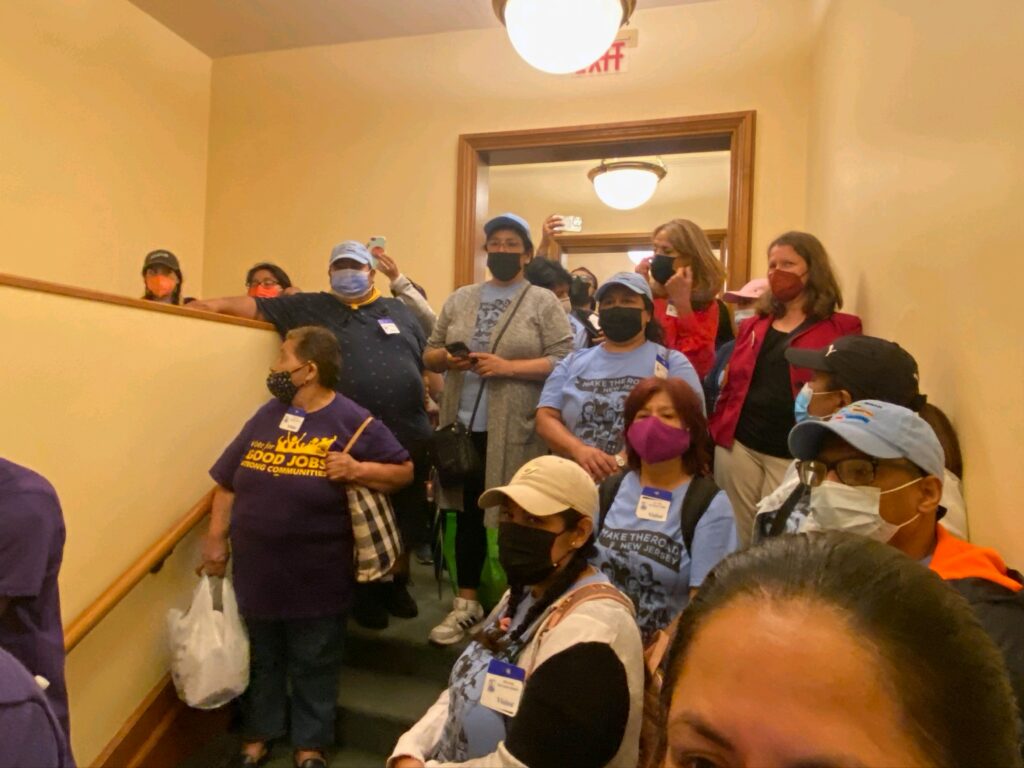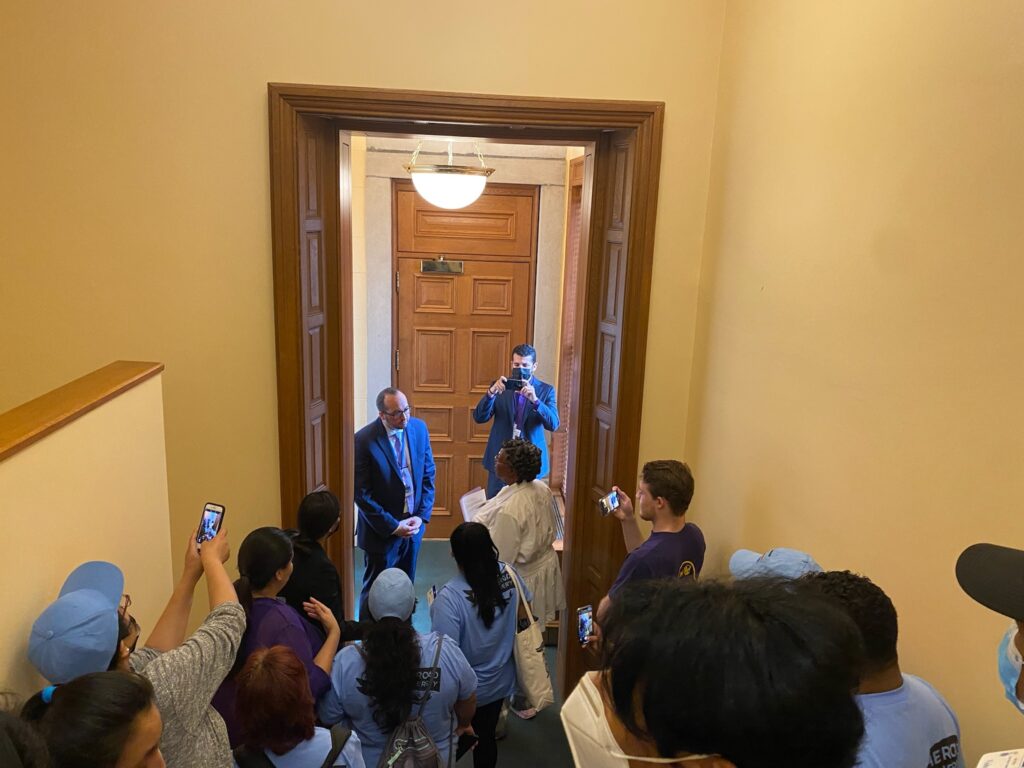Burlington Does More than Bang Pots for its Essential Workers

Burlington County is extending hazard pay retroactively to its frontline workforce who worked during the pandemic putting themselves and their families at risk of infection from the deadly virus that killed over one million Americans. The County Commissioners have authorized up to $5 million to be spent for that purpose from the funds it received from the federal government’s American Rescue Plan enacted last year. No county taxpayer funds will be used.
Under the American Rescue Plan passed by Congress local, county and state governments are authorized to use their local grant aid for such hazard pay.
Minnesota provided $500 million in hazard pay to an estimated 667,000 essential workers with payments of $750. Puerto Rico allocated $200 million to provide $2,000 payments to essential workers. Connecticut has approved $65 million in hazard pay: $30 million to its essential private sector employees ($1,000 for full-time and $500 for part time workers) and $35 million for state employees.
“From the very beginning of the pandemic, our County has done everything possible to help our

residents overcome the challenges of COVID-19. We distributed personal protective equipment (PPE) and supplies, launched testing and vaccine clinics and delivered services that people needed throughout the pandemic,” Burlington County Commissioner Director Dan O’Connell said. “None of it could have happened without these dedicated employees who faced substantial risks while working during the pandemic. They stepped up at a time of great uncertainty and delivered essential services and resources that others continue to rely upon.”
Under the hazard pay provision the pandemic premium will only be extended to county workers who performed essential work the majority of their time during the public health emergency and their total wages were less than $100,680. County Commissioners, department heads and others that are exempt from the overtime provisions of the Fair Labor Standards Act are not eligible.
According to the county, “the American Rescue Plan Act defines ‘essential work’ as work that is ‘not performed while teleworking from a residence and involves either regular, in-person interactions with patients, the public or co-workers’ or requires ‘regular physical handling of items that were handled by or are handled by patients, the public or coworkers.’”
Burlington County’s workforce rank and file as well as managers adds up to around 1,200 employees. A county spokesperson said it was currently sorting out employee eligibility.
“It’s a responsible plan that is both capped and designed to support those workers who were on the frontlines during the pandemic and worked with the public or performed other essential tasks and services that our residents needed,” O’Connell said. “It’s compensation these workers deserve and earned, and distributing it is another way to aid them and their families during this period of recovery.”
“We’re proud of our response and we know our employees are the ones responsible for implementing it,” said Commissioner Felicia Hopson, the Commissioners’ liaison to the County Health Department and Department of Human Services. “Providing them this compensation is the right thing to do for them and for our residents who have depended on these workers and these services.”
A similar proposal with a $100 million price tag that is being promoted by the New Jersey AFL-CIO for the state’s essential workers has stalled in Trenton.
In a joint statement, New Jersey AFL-CIO President Charles Wowkanech and Secretary-Treasurer Laurel Brennan hailed Burlington County for it’s “moral leadership” but noted that “unfortunately, the State has declined to compensate New Jersey’s frontline heroes for the extreme personal risks they took to save lives and ensure the delivery of goods and services during the darkest days of the pandemic. We call on the State to follow Burlington County’s example.”

The NJ AFL-CIO statement continued. “We would like to thank Burlington County Commissioner Director Dan O’Connell for making COVID-19 hazard pay for county workers a priority. As a graduate of our Labor Candidates School and long-time member of SMART Transportation Division, where he served as Legislative Director, Commissioner Director O’Connell understands working families issues and demonstrates the value of having union members in elected office.”
The state AFL-CIO’s proposal for hazard pay would require that it be limited to workers who were in the 1a or 1b vaccine eligibility groups, having performed at least 500 hours of work from March 16, 2020 to May 7,2021 when vaccines became widely available. Full time workers would get $1,000 and part time workers $500. Only workers whose annual income is 100 percent of the state’s average annual wage for all occupations which is $67,120.
“We had within New Jersey Transit ATU, which represents 5,000 bus drivers—they had a lot of fatalities and a lot of sicknesses—the United Food & Commercial Workers who were on the frontline—just as the nurses and everybody else,” said Wowkaneck during an interview in his Trenton office back in June. “They were in the Shop Rites and the ACMES keeping food on the shelves in the very beginning before vaccination, before PPE, there was a lot of sickness, a lot of loss of life across all of these unions. And even now, quite frankly with the uptick and spike [it remains an issue]. I have two people out of my office right now that have it.”
The NJ AFL-CIO leader continued. “We feel very strongly that a lot of this money that came out of Washington that Biden is talking about was supposed to go to help working families. A lot of these unions and their families suffered tremendously and we just don’t think it’s too much to ask some special consideration if what we are calling hazardous pay. These people went to work everyday with the fear of bringing the virus back home to their families and children. In fact, that did happen.”
Though no official registry has been kept of essential workers who perished during the pandemic, thousands of essential workers in healthcare, law enforcement, congregant care, transportation, retail and food processing died from the virus. Individual unions have tried to track the members they have lost to the virus.
According to the CWA’s COVID Memorial page close to 70 members lost their life during the pandemic including public employees with the New Jersey Department of Transportation, the Department of Motor Vehicles, the New Jersey Performing Arts Center, the New Jersey Department of Children and Families, as well as at Greystone Park Psychiatric Hospital.
A joint investigation by the Guardian Newspaper and Kaiser Health News found that 3,600 healthcare workers died in the first year of the pandemic when there was widespread shortages of personal protective equipment and the vaccines were not yet in distribution.
But the deaths of essential workers is only part of the lasting impact on the American workforce.
A recent Brookings Institute analysis found that “around 16 million working-age (those aged 18 to 65) have long COVID today, of those, two to four million are out of work due to long COVID.” More than two years into this pandemic, we still have no accurate assessment of the impact of COVID on the essential workforce, though such an analysis is pending at the Centers for Disease Control and Prevention (CDC).









Leave a Reply